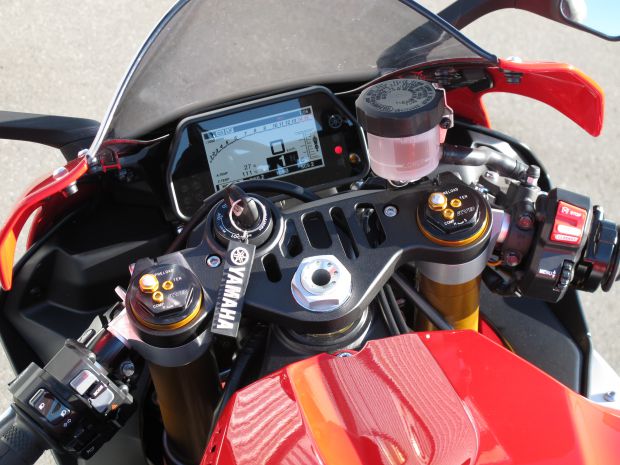Yamaha YZF-R1 2015. As part of the Yamaha R1 Track Days we had the opportunity, the YZF-R1 at the Nurburgring to test extensively. Yamaha Germany presented as part of Dunn-Racing event in addition to the brand new R1, the R125, R3, R6 and R1M - ie the complete R-series 2015. We concentrated fully on the R1. Directly at the Pit Lane, the devices were for that day lined up - blue and red with silver or white R1`sen elements. Already the first sight captivates one's eyes and can not deviate from it a. The R1 is different, different from the uniform look and sets trigger points. There are at this bike so much to discover, to explore so many details - exciting! Yamaha promises 200hp at 13,500 rev / min and 112.4 Nm at 11,500 rev / min, combined with a weight of 199 kg in road trim, ie 1 kg per horsepower - that's for a clear statement. Was blocked everything extremely compact and centrally-spaced between 1,405 mm Magnesium Alloy wheels - a bike for the Racetrack. The 5,148 m long Grand Prix circuit of the Nürburgring should we definitely give much opportunities of experiencing the MotoGP genes R1.
The conditions were great, sick sun, blue sky, best temperatures, so fast times behind an instructor of Dunn-Racing the track and the bike to get to know. First impression when sitting was itself very well. Handlebar ergonomics and setting the lever estates are absolutely perfect, the sitting position with 855mm quite high and the catches a super athlete accordingly very athletic, but then what presupposes movable knee at the size of the test driver of just 1.90 m. Knee grip on the tank fits nevertheless, was ever a very safe and direct feel. The soundscape during roll out and on the first laps was still a bit reluctant, but this should change very quickly with stronger and especially violent rotation of the throttle grip itself.
Yamaha YZF-R1 - MotoGP Bike Series in which R1 has some of it
Time to deal with the myriad of setting modes and the electronics, because nowadays are motorcycles in this class, with performance values that 15 years ago, not even the MotoGP had without the impeccable combination of sensors readings and interventions of a central processing unit unthinkable. Who wants in the Superbike scene play above which must dominate everything and give the driver any degree of freedom to personal programming. And does the new R1, one night Check and test here is not nearly enough.
Thus, the YZF-R1 has a self-developed sensor unit consisting of yaw rate sensors for tilting, rolling motion and movements in the yaw axis and accelerations in all directions. All parameters are picked and processed 125 times per second. This flood of data makes use of the control unit to the braking force optimally distribute to regulate the injection quantities and optimally control the ignition timing and the opening angle of the throttle. The bottom line presents itself as always an extremely stable driving condition and allows one, among other things the use of Slide Control (SCS), ie the controlled oversteer the rear wheel when accelerating - Genuine MotoGP technology! Of course, these data are also used for the 9-way adjustable traction control (TCS), Lift Control System (LIF) and Launch Control (LCS) and the circuit breaker (QSS) - but only upwards - used. Furthermore, the control of the throttle and thus the response in 4 different stages can be controlled.
Shown are all values on the beautiful TFT display, which is confined in Race mode on the essential information and so very clear. Controlled the whole story is about two buttons on the handlebar. Who is properly fit, the compiles all parameters and stores them in 4 different basic settings that can be changed only in the state, however. R1M owners have further one interface - the Communication Control Unit (CCU), which they conveniently via PC, tablet or smartphone make and save all values and settings (can also be retrofitted with the R1). However, only the motor modes, traction control and slide control can then be on the left handlebar adjusted gradually while driving.
Drive YZF-R1 - high-quality technology and quality materials
An absolute technical highlight: the short-stroke Crossplane machine at the crank pins are offset by 90 degrees so that the forged pistons never operate in parallel as in other series quads. This Yamaha achieved a more uniform torque curve and passing a striking muffled sound. In combination with a significantly lower flywheel, titanium conrods with cracked connecting rod and significantly speed firmer cam followers, these are important cornerstones of a free-revving and powerful engine.
This revving it shows the Yamaha clearly because at already 6,000 U / min pushes powerful and unstoppable, which only ends beyond 12,000 trips. The whole thing is happening this extremely uniform and manageable at all times - ok, you have to, especially in the power mode 1 used to the hard onset power, but this has been, everything goes great and dosed directly from equip. Up in the red zone, it must nevertheless not really be hunted because top wird's but somewhat tougher.
Yamaha R1 - electric bike with a combustion engine
Electronics without end, but that really works? So helmet on, gloves on, quickly stretch a bit and then find the right position on the tight seat cushion. Pit exit, 2.Gang, full throttle: Wooooh, deep growl, the front end rises rapidly, remains on top, not too far, cool. Stop, slowly, the 190er Pirelli Super Corsa SP are 40 minutes prior certainly not warm, so the first few corners somewhat more restrained to work - is the electronic one, the other physics! Long left bend, deep inside, the R1 is great to come back very briefly gas, left, quickly tilt to the right, works just fine. Full throttle Second, 3rd gear, the front wheel is easy, the TCS controls smoothly. Gas away, left braking briefly early on the throttle and the same times overtake around the outside one. Take right and then ran to the gas up high to 4th - the throttle response is used to, is already a quite hard. Braking right outer, again deep inside, the boot drags, gas! Wooooh, that was the Slide-Control or why did you feel to come across? Uphill to the left, right, hard braking, then wide line on the left and immediately right down at full throttle until almost the end of 5th gear. Harassment, downshifting, by shortly Gas and right again onto the start-finish. The destruction of the power end from start to finish or between Schumacher and Bilstein curve, however, has not always been quite as precise as desired possible. Although the stopper function properly, could be biting and aggressive in our opinion, however. Can be optimized determined with a few other brake pads. However - here comes Lorenzo feeling on!
The test day was now somewhat advanced, understood the settings and made, so now we went drum to use everything fully, earlier to go to the gas, even more to bring the helpers to work, easy to get into a real flow with the R1 , And who came too damn fast. Lap after lap, it went ahead ever faster and more spectacular. Light-footed like a 600, the 200PS-R1 snaked through the chicane before the start-finish. Braking, fast left, tilt to the right, creating gas, playful and precise. The Pirelli Super Corsa SP (each on a Superbike Top choices) set all command to perfectly and the chassis did exactly what you expect from a Super Sport chassis expected. With this rapid pace, also had the steering damper intervene occasionally reassuring when the forequarters yet started easy to prance when Raus accelerating over bumps - but he's there. Great round!
Whether the Yamaha YZF-R1 is now the best choice for the race track, is as easy to not answer. Here takes a direct comparison with the competition take place. But you hear in any case the first choice. A Aprilia RSV4 requires an optimal suspension settings to similar to whet around the corners. The Ducati 1299 Panigale has got more pressure medium speed range, but it is less easy to turn. And BMW S1000RR shines with the best all abilities, though it does not serve up the playful handling of the R1.






EmoticonEmoticon